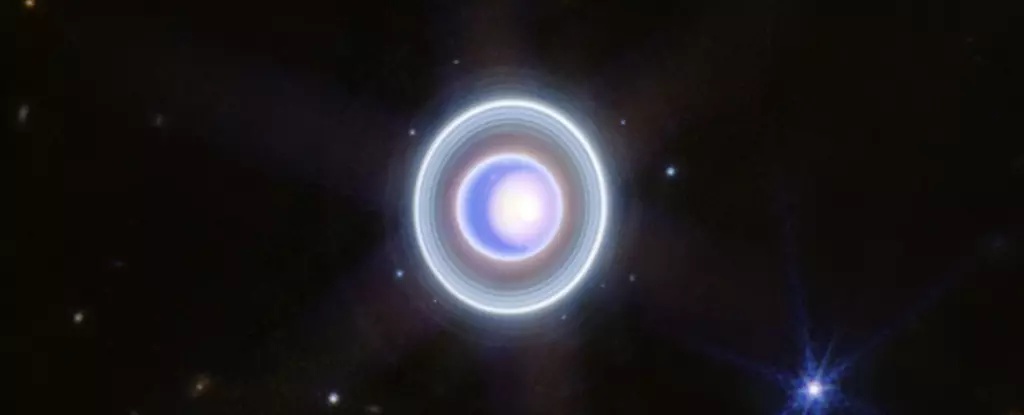The exploration of Uranus has long intrigued astronomers and scientists, as this distant blue planet showcases a unique set of characteristics and an enigmatic magnetic field. Historically, the prevailing view of Uranus has been informed by data obtained from NASA’s Voyager 2 during its flyby in 1986. Initial interpretations suggested that Uranus possessed an exceptionally irregular magnetosphere, characterized by a magnetic field that is significantly tilted and offset compared to other planets in our Solar System. This has led researchers to question traditional understandings of Uranus’s geological and atmospheric dynamics. However, new research led by Jamie Jasinski at NASA’s Jet Propulsion Laboratory proposes a more nuanced interpretation of these findings—one that could reshape how we view this distant planet and its complex interactions with solar phenomena.
The Voyager 2 mission remains unparalleled in its contributions to our knowledge of Uranus, providing the first close-up observations of the planet and its surroundings. The data collected indicated a magnetic environment unlike that of any other celestial body, characterized by intense radiation belts and an unexpected scarcity of plasma. For many years, scientists have accepted these observations as indicative of Uranus’s intrinsic qualities, but Jasinski’s research suggests these readings may reflect an anomalous event rather than the planet’s typical state.
A critical aspect of this re-evaluation hinges on solar activity during the time of the Voyager 2 flyby. By analyzing solar wind data leading up to the observations, Jasinski and his team noted a dramatic increase in solar wind dynamic pressure just prior to the spacecraft’s encounter with Uranus. This spike in solar activity resulted in the planet’s magnetosphere becoming compressed to about 20% of its usual volume. Consequently, these abnormal conditions could have led to misleading data concerning Uranus’s magnetic field during the flyby.
Understanding Uranus’s magnetosphere requires consideration of the solar wind’s role as a variable that can significantly alter the planet’s outer environment. The solar wind—a continuous stream of charged particles emitted by the Sun—interacts with planetary magnetic fields and can create fluctuating conditions that affect observational data. Jasinski’s hypothesis suggests that the Voyager 2 findings might not represent the average state of Uranus but rather a snapshot of a moment when solar activity skewed the readings.
Drawing a parallel to his work on the MESSENGER mission, which studied Mercury, Jasinski emphasizes that planetary conditions can shift dramatically based on solar influences. During specific periods of heightened solar activity, the magnetic fields of even the closest planets can appear misrepresented. Thus, if Voyager 2 had conducted its flyby during a more typical solar wind state, it is likely that scientists would have observed a magnetic field more akin to those of other gas giants such as Jupiter or Saturn.
The ramifications of this newly analyzed data are extensive. By suggesting that earlier assumptions about Uranus’s magnetic field may be fundamentally flawed, Jasinski’s work prompts scientists to reconsider the planet’s internal structure and dynamics. Instead of viewing the interior as a unique geological formation unlike any in the known Solar System, it becomes important to reevaluate this view to include the variability imposed by external solar activity.
This reflects a broader issue in planetary science—the challenge of drawing definitive conclusions based on limited observational data. The fleeting nature of the Voyager 2 encounter with Uranus highlights the importance of dedicated missions designed to gather more comprehensive data. For years, scientists have advocated for renewed exploration of both Uranus and its companion Neptune, arguing those missions could provide the necessary insights to confirm or dispute Jasinski’s findings and further illuminate the dynamic processes governing these distant worlds.
Uranus’s complexities extend beyond its magnetic field, with implications for its numerous moons and overall system dynamics. If, as Jasinski theorizes, the unusual solar conditions encountered during the flyby influenced Voyager 2’s findings, this raises questions about the potential for undiscovered geological or atmospheric phenomena within Uranus’s moon system.
The wind of change regarding our understanding of Uranus is upon us. New analysis suggests the planet’s erratic magnetosphere may not be as inherently strange as previously thought, but rather the product of transient solar conditions. As we advance our capabilities in space exploration, the challenge moving forward will be to develop missions capable of walking the thin line between unique anomalies and consistent planetary behavior—ultimately bringing us closer to unlocking the secrets of Uranus and its intriguing solar connections.


Leave a Reply